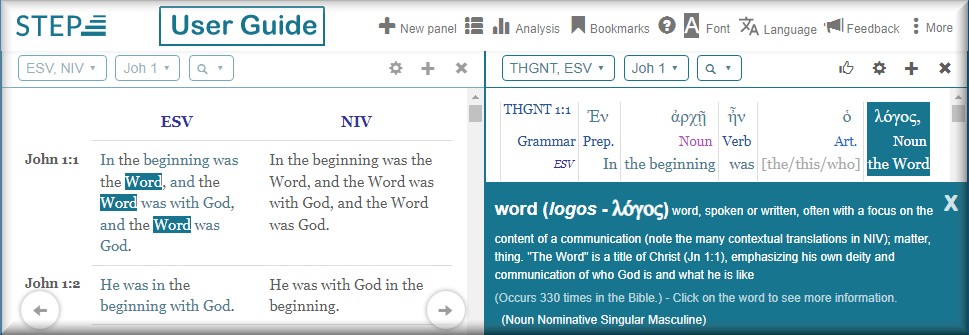About the planned Manuscripts and Meanings ToolsAll bible translations represent decisions about what the original text was (based on manuscripts) and what the original text was intended to convey in the original culture (the meaning). A multitude of translations in modern languages confronts a bible student with numerous alternatives. These have been compiled in English using the ESV as a base text to produce Manuscripts and Meanings, a STEPBible feature that is currently under development.
The Manuscripts and Meanings feature is intended to:
To use Manuscripts and Meanings, you must have chosen the ESV Bible version for display:
Gen.11.31: ... his son Abram's wife, and they went forth together from Ur You will see a popup when you hover over the text, saying: The various elements of this popup provide more information on hover or click: Prob: The probable older version, as determined by Barthélemy's UBS committee. Rated: Likely. he took them out: Based on Hebrew emendation ויוציא אתם instead of יֵּצְאוּ אִתָּם Hebrew: All Hebrew manuscripts including the Leningrad Codex have this text. some Hebrew: Hebrew manuscripts that do not include Leningrad Codex have this text. most Hebrew: Hebrew manuscripts including Leningrad Codex have this text. Samaritan: Supported by the text of one or more Samaritan Pentateuch manuscripts Greek: Supported by translation in one or more Old Greek / Septuagint manuscripts Syriac: Supported by translation in one or more Old Syriac / Peshitta manuscripts Latin: Supported by translation in one or more Old Latin / Vulgate manuscripts Aramaic: Supported by translation in one or more Aramaic Targums If this alternative existed at Qumran then the "Prob:" line would include: Qumran: Supported by the text of one or more of the Judean / Dead Sea Scrolls Occasionally an emmendation with no manuscript support is marked as: Theoretical: A suggestion that currently has no support from any manuscripts Different meanings are due to different translation styles or the ambiguity of the original word. STEPBible marks them as follows (more details here):
Different manuscripts give evidence about the original Hebrew and Greek text. Scholars have studied these for hundreds of years and there is broad consensus about the conclusions. STEPBible marks the specific conclusions by the committees set up by the United Bible Society (UBS) as follows:
|
- Hebrew - (i.e. Masoretic) This is always the reading of the Leningrad codex that examplifies other manuscripts. When other Hebrew sources are noted elsewhere, this is labelled as "most Hebrew".
- some Hebrew - old Hebrew manuscripts that differ from the Leningrad codex, including:
- Qumran - Hebrew texts placed in caves in the Judean desert, about 200-0 BC
- Geniza - Hebrew texts stored in a Cairo Synagogue about 900-1100 CE
- Samaritan - a separate tradition of the Pentateuch preserved by Samaritans
- Aramaic - (i.e. Targums) Translations of Hebrew manuscripts from about 0-600 CE
- Syriac - (a.k.a. Peshitta) Translations of Hebrew manuscripts from about 200 BC - 200 CE
- Greek - (i.e. Old Greek & Septuagint) Translation of Hebrew manuscripts about 200-100 BC
- Latin - (i.e. Vulgate & Old Latin) Translations of Hebrew manuscripts from 0-400 CE
- Scribes - Notes by scribes from margins of Hebrew manuscripts or ancient tradtions (i.e. Qere & Tiqqune & Itture etc; more details here)
- theory - a reasonable conjecture which does not yet have any manuscript support
NT Manuscript differences come from thousands of surviving Greek manuscripts in various forms and ancient translations as follows (more details here):
- p1, p2 etc. - Papyri (i.e. written on papyrus). 85 of which originate before 500 AD
- 01, 02 etc. - Uncials (i.e. written all upper case, on parchment). 74 originate before 500 AD
- 1, 2 etc. - Minuscule (i.e. written mostly in lower case). None originate before 500 AD
- L1, L2 etc. - Lectionaries (i.e. daily readings). 2 originate before 500 AD
- Q1, Q2 etc - Quotations mainly from church Fathers. 215 sources originate before 500 AD
- Lt - (i.e. Old Latin). Translations of Greek manuscripts. 15 originate before 500 AD
- Vg - (i.e. Jerome's Vulgate). Translation from Greek by Jerome about 400 AD
- Cp - (i.e. Coptic). Translation into a popular language of Egypt in 3rd or 4th century
- Sy - (i.e. Peshitta). Translation into Syriac in the 4th century
- Ar - (i.e. Armenian). Translation in the 5th century based on Syriac manuscripts
- Gg - (i.e. Georgian). Translation in the 5th century probably based on Armenian.
- Maj - (i.e. Majority Text). An edition based on Byzantine manuscripts from 6th to 15th century
- UBS - (i.e. UBS 3/4/5 & NA 27/28 Text). Editions based primarily on the earliest manuscripts.
For more information about the concepts behind the Manuscripts and Meanings Feature, review these pages, which focus on this subject:



